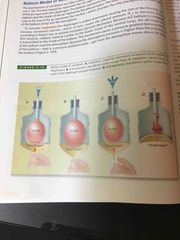![]()
![]()
![]()
Use LEFT and RIGHT arrow keys to navigate between flashcards;
Use UP and DOWN arrow keys to flip the card;
H to show hint;
A reads text to speech;
16 Cards in this Set
- Front
- Back
- 3rd side (hint)
|
Ventilation |
The process that moves gases between the external environment and the alveoli |
|
|
|
Patm/ Pb |
Atmospheric pressure/ barometric pressure |
|
|
|
mmHG |
Millimeters of mercury |
|
|
|
Pressure gradient |
An area with a difference in pressure where gas or liquid moves from high pressure to low pressure |

|
|
|
Primary principles of ventilation |
The mechanisms of pulmonary ventilation that create a pressure gradient |
|
|
|
Boyle’s Law |
States that a volume of gas varies inversely proportional to its pressure at constant temperature |
|
|
|
Driving Pressure |
The pressure difference between two points in a tube or vessel |
|
|
|
Transrespiratory Pressure (Prs) |
The difference between the barometric pressure (PB) and the alveolar pressure (Palv) |
Prs = Pb - Palv |
|
|
Transmural pressure (Ptm) |
The pressure difference that occurs across the airway wall |
Ptm = Pressure from the outside of the airway (Poaw) - intraairway pressure (Piaw) |
|
|
Transpulmonary Pressure |
The difference between the alveolar pressure and the pleural pressure |
Ptp= Palv - Ppl |
|
|
Trans thoracic pressure (Ptt) |
The difference between the alveolar pressure (Palv) and the body surface pressure (Pbs). |
Ptt = Palv - Pbs |
|
|
Hyperventilation |
increased alveolar ventilation ( produced by any ventilatory pattern that causes an increase in either the ventilatory rate or the depth of breathing) therefore the PaCO2 to decrease |
|
|
|
Hypoventilation |
decreased alveolar ventilation (produced by any ventilatory pattern that causes a decrease in either the ventilatory rate or the depth of breathing) that causes PaCO2 and therefore the PaCo2 to increase |
|
|
|
Where do aspirated contents lay in the lung? |
The lower lung, usually the right |
|
|
|
Where do aspirated contents lay in the lung? |
The lower lung, usually the right |
|
|
|
State the average pleural pressure at the end of a passive exhalation |
758 mm HG |
|

